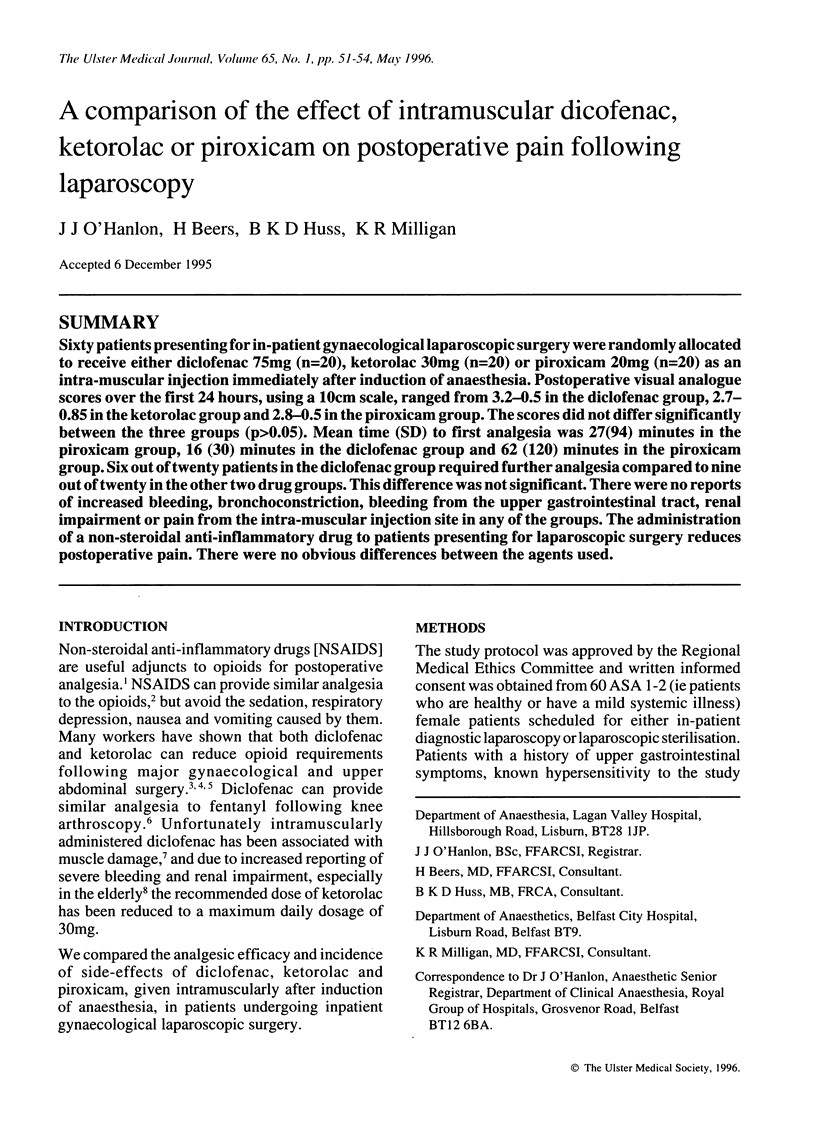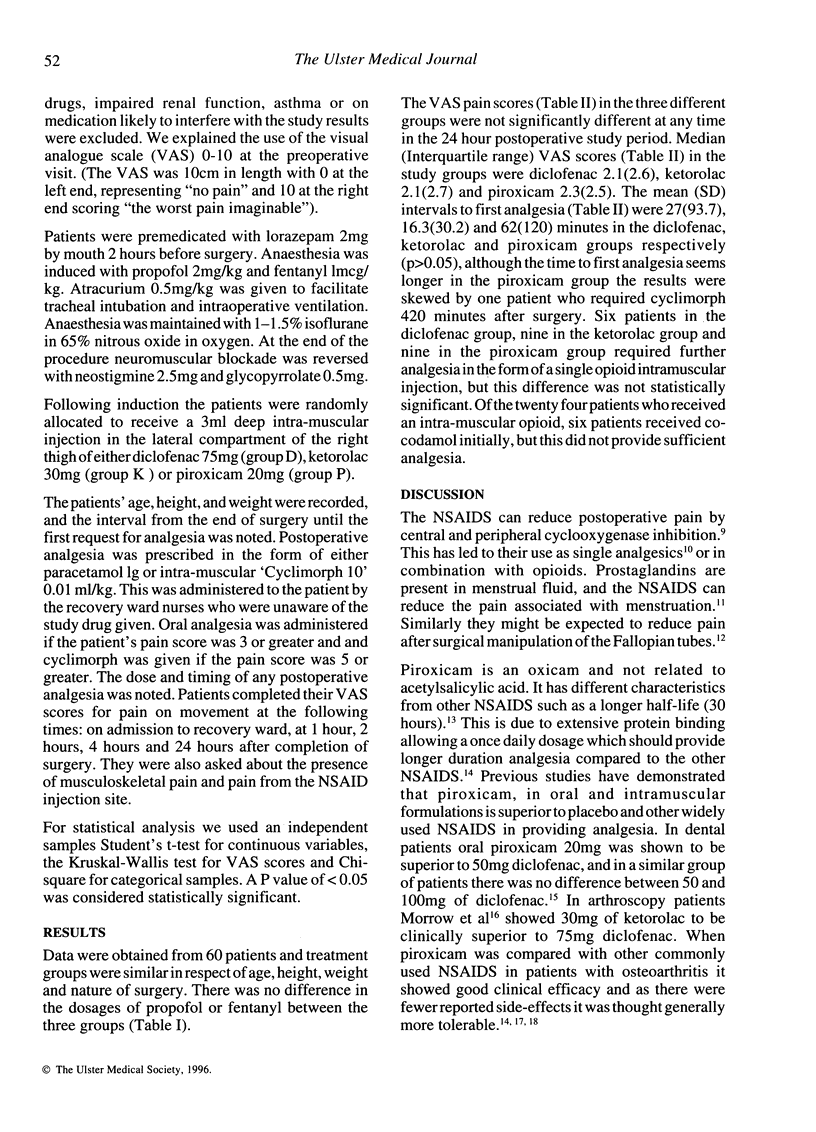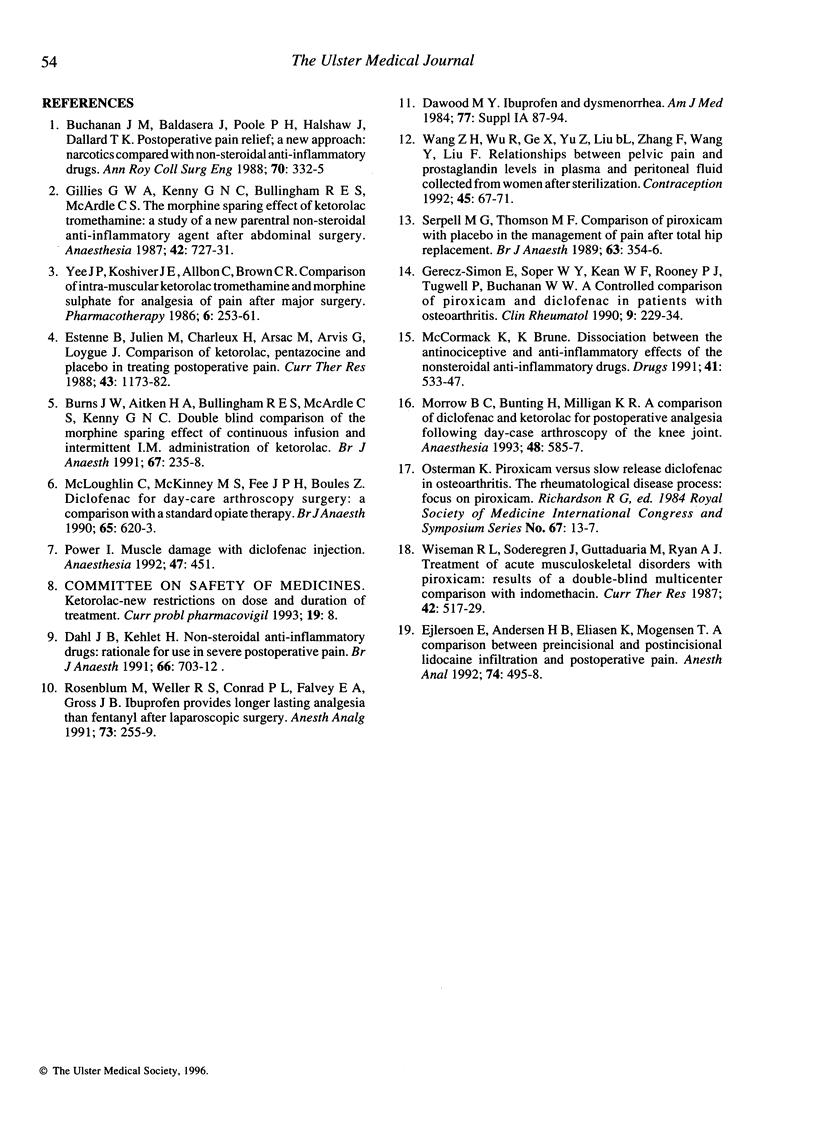Abstract
Sixty patients presenting for in-patient gynaecological laparoscopic surgery were randomly allocated to receive either diclofenac 75 mg (n = 20), ketorolac 30 mg (n = 20) or piroxicam 20 mg (n = 20) as an intra-muscular injection immediately after induction of anaesthesia. Postoperative visual analogue scores over the first 24 hours, using a 10 cm scale, ranged from 3.2-0.5 in the diclofenac group, 2.7-0.85 in the ketorolac group and 2.8-0.5 in the piroxicam group. The scores did not differ significantly between the three groups (p > 0.05). Mean time (SD) to first analgesia was 27(94) minutes in the piroxicam group, 16 (30) minutes in the diclofenac group and 62 (120) minutes in the piroxicam group. Six out of twenty patients in the diclofenac group required further analgesia compared to nine out of twenty in the other two drug groups. This difference was not significant. There were no reports of increased bleeding, bronchoconstriction, bleeding from the upper gastrointestinal tract, renal impairment or pain from the intra-muscular injection site in any of the groups. The administration of a non-steroidal anti-inflammatory drug to patients presenting for laparoscopic surgery reduces postoperative pain. There were no obvious differences between the agents used.
Full text
PDF



Selected References
These references are in PubMed. This may not be the complete list of references from this article.
- Buchanan J. M., Baldasera J., Poole P. H., Halshaw J., Dallard J. K. Postoperative pain relief; a new approach: narcotics compared with non-steroidal anti-inflammatory drugs. Ann R Coll Surg Engl. 1988 Sep;70(5):332–335. [PMC free article] [PubMed] [Google Scholar]
- Burns J. W., Aitken H. A., Bullingham R. E., McArdle C. S., Kenny G. N. Double-blind comparison of the morphine sparing effect of continuous and intermittent i.m. administration of ketorolac. Br J Anaesth. 1991 Sep;67(3):235–238. doi: 10.1093/bja/67.3.235. [DOI] [PubMed] [Google Scholar]
- Dahl J. B., Kehlet H. Non-steroidal anti-inflammatory drugs: rationale for use in severe postoperative pain. Br J Anaesth. 1991 Jun;66(6):703–712. doi: 10.1093/bja/66.6.703. [DOI] [PubMed] [Google Scholar]
- Dawood M. Y. Ibuprofen and dysmenorrhea. Am J Med. 1984 Jul 13;77(1A):87–94. doi: 10.1016/s0002-9343(84)80025-x. [DOI] [PubMed] [Google Scholar]
- Ejlersen E., Andersen H. B., Eliasen K., Mogensen T. A comparison between preincisional and postincisional lidocaine infiltration and postoperative pain. Anesth Analg. 1992 Apr;74(4):495–498. doi: 10.1213/00000539-199204000-00004. [DOI] [PubMed] [Google Scholar]
- Gerecz-Simon E., Soper W. Y., Kean W. F., Rooney P. J., Tugwell P., Buchanan W. W. A controlled comparison of piroxicam and diclofenac in patients with osteoarthritis. Clin Rheumatol. 1990 Jun;9(2):229–234. doi: 10.1007/BF02031974. [DOI] [PubMed] [Google Scholar]
- Gillies G. W., Kenny G. N., Bullingham R. E., McArdle C. S. The morphine sparing effect of ketorolac tromethamine. A study of a new, parenteral non-steroidal anti-inflammatory agent after abdominal surgery. Anaesthesia. 1987 Jul;42(7):727–731. doi: 10.1111/j.1365-2044.1987.tb05317.x. [DOI] [PubMed] [Google Scholar]
- McCormack K., Brune K. Dissociation between the antinociceptive and anti-inflammatory effects of the nonsteroidal anti-inflammatory drugs. A survey of their analgesic efficacy. Drugs. 1991 Apr;41(4):533–547. doi: 10.2165/00003495-199141040-00003. [DOI] [PubMed] [Google Scholar]
- McLoughlin C., McKinney M. S., Fee J. P., Boules Z. Diclofenac for day-care arthroscopy surgery: comparison with a standard opioid therapy. Br J Anaesth. 1990 Nov;65(5):620–623. doi: 10.1093/bja/65.5.620. [DOI] [PubMed] [Google Scholar]
- Morrow B. C., Bunting H., Milligan K. R. A comparison of diclofenac and ketorolac for postoperative analgesia following day-case arthroscopy of the knee joint. Anaesthesia. 1993 Jul;48(7):585–587. doi: 10.1111/j.1365-2044.1993.tb07121.x. [DOI] [PubMed] [Google Scholar]
- Power I. Muscle damage with diclofenac injections. Anaesthesia. 1992 May;47(5):451–451. doi: 10.1111/j.1365-2044.1992.tb02256.x. [DOI] [PubMed] [Google Scholar]
- Rosenblum M., Weller R. S., Conard P. L., Falvey E. A., Gross J. B. Ibuprofen provides longer lasting analgesia than fentanyl after laparoscopic surgery. Anesth Analg. 1991 Sep;73(3):255–259. doi: 10.1213/00000539-199109000-00004. [DOI] [PubMed] [Google Scholar]
- Serpell M. G., Thomson M. F. Comparison of piroxicam with placebo in the management of pain after total hip replacement. Br J Anaesth. 1989 Sep;63(3):354–356. doi: 10.1093/bja/63.3.354. [DOI] [PubMed] [Google Scholar]
- Wang Z. H., Wu R. F., Ge X. L. Relationships between pelvic pain and prostaglandin levels in plasma and peritoneal fluid collected from women after sterilization. Contraception. 1992 Jan;45(1):67–71. doi: 10.1016/0010-7824(92)90142-g. [DOI] [PubMed] [Google Scholar]
- Yee J. P., Koshiver J. E., Allbon C., Brown C. R. Comparison of intramuscular ketorolac tromethamine and morphine sulfate for analgesia of pain after major surgery. Pharmacotherapy. 1986 Sep-Oct;6(5):253–261. doi: 10.1002/j.1875-9114.1986.tb03485.x. [DOI] [PubMed] [Google Scholar]


